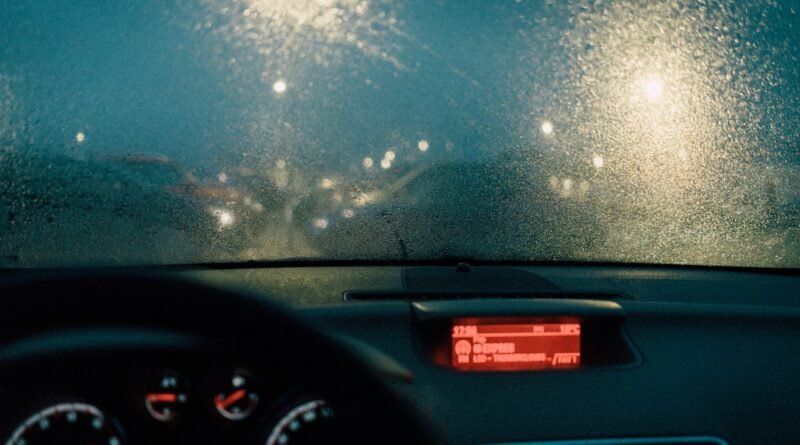Care for driving in the rain: increase your protection
Whether it’s when you’re just starting to drive or when you’ve been doing it for a while, getting caught in the rain while commuting is a big challenge, even if there aren’t many cars around you. And the big reason behind this is that, in situations like this, the car becomes more unstable and can skid or even roll over, increasing — greatly — the chance of suffering or causing a traffic accident.
But for those of you who want to know how to learn to drive in the rain or want to improve your driving in this type of situation, we invite you to check out the tips and precautions for this moment. Come with us to find out everything!
Some care for your vehicle
Before you even hit the streets, there are some car precautions that are necessary to avoid any type of mishap that rain can cause.
Of course, most of them concern your vehicle’s accessories and systems, but it doesn’t stop there! So check out everything you need to analyze below.
Check the cleaners
The first thing you need to analyze, without a doubt, is the windshield wiper , both the front and rear, a fundamental point as it is the way to have visibility of the road.
Keep an eye out if the piece is making any kind of strange sound and/or if the rubber is scratching the glass. If this is the case, it’s time to change your wiper, so do it as soon as possible.
Check the condition of your tires
The car tire is another area that you need to be careful with as, if it accumulates a lot of water instead of draining it, it is possible to suffer from hydroplaning and lose control of the vehicle. So keep an eye out to see if it’s time to replace this important item!
The idea here is to frequently check the depth of the grooves on the four tires to find out the condition of the rubber. If the depth is less than 3 mm, it is possible that the water does not drain correctly, compromising your safety.
Flashlight and headlights
Lighting is essential on rainy days. And whether you’re driving in the rain at night or during the day, you need to use your taillights and low beams. The reason is quite simple: while it rains, the sky usually closes and the day becomes darker, which requires the correct lighting to be visible to what is in front of you.
Therefore, check your car’s headlights , low beams, signals, hazard lights and turn signals to avoid more than just an accident, but also a fine with 4 points on your license for not driving with adequate lighting in the situation.
Car brake and air system
The car’s brake is responsible for stopping the vehicle in all situations. And to avoid problems, it needs to be in good condition so that you can stop without hitting the vehicle in front.
Therefore, the idea is to check the brake fluid, discs, cylinders, calipers and all other components to avoid problems. The best thing to do is to check it from time to time , but if you hear any different sounds or see that it’s taking a while to brake, take it to a mechanic as soon as possible as it could be time for maintenance!
When we talk about the air system, we are getting into the issue of defogging the windows which will make it difficult to see in the rain even with adequate lighting. So be sure to maintain the air intakes and ventilation system as this is the best way to defog the glass quickly and effectively, avoiding driving without visibility or having to stop the vehicle.
Find out if your insurance covers flooding
Depending on how much rain you are experiencing and where you are, there is the possibility of witnessing flooding . And the best way to act in a situation like this is to activate your car insurance to have all the necessary support to avoid losses, if it covers this situation, of course.
But the good news is that this is most likely one of your insurance coverages as it is a natural disaster . In any case, it’s better to be safe, right? So, contact the insurance company you hired and find out if you can count on the company’s full support if you pass through a flooded area or lose your car in a flood.
Tips to avoid problems during the rain
After checking the precautions when driving in the rain with regards to your vehicle’s accessories, let’s look at care tips while you’re driving. Some may seem obvious, but it’s always good to remember to avoid problems! See below:
Reduce speed
Even when traveling on expressways, something you should do when faced with rain is take your foot off the accelerator, in order to reduce the car’s speed. By doing this you avoid problems due to the risks posed by a wet road. So reduce to at least 80% of the speed limit on the road, and the more cars are traveling, the slower you should go.
This way, in addition to reducing the countless accidents you can cause, you avoid the possibility of suffering aquaplaning , a term that refers to a situation where the car appears to be floating due to losing contact with the ground. In cases like this, you start to slide and can also skid or overturn, in addition to losing control of the vehicle.
If you encounter this situation, keep both hands firmly on the steering wheel, take your foot off the accelerator and keep the vehicle straight, but don’t despair. By doing this, he will get out of the situation on his own over time and you will feel like you are back in control when he hits the asphalt again.
Just be careful not to use the brake under any circumstances or turn the steering, as this could lock the wheels and cause the car to roll over, ok? In any case, by driving slowly in the rain you reduce the chances of experiencing a problem like this.
Turn on the low beam
In order to have the best visibility while driving in the rain , turn on your vehicle’s low beams, especially if the day is foggy. By doing this, your field of vision increases, making it possible to see puddles and holes and making your vehicle more visible to other drivers. On the other hand, this is a mandatory action by law, so avoid taking an unnecessary fine, just for lack of attention!
Be careful not to turn on the high lights, okay? After all, this type of light reflects off raindrops and only worsens your vision, and it is not mandatory.
Avoid overtaking
It may seem obvious, but as it is a risky maneuver, do not overtake if it is raining. It’s because?
To overtake you need to accelerate, which can be a very big risk, with chances of accidents and rollovers as well. So even if you’re in a big hurry, avoid overtaking other cars for your own safety, and that of others too.
Activate the windshield wipers and defrosters
In the topic regarding accessories, we mentioned the windshield wiper and defroster, remember? Well, in the rain it is highly recommended to turn on both; the first to remove the water that is on the glass and compromises your vision (also remember that driving in the rain without using the windshield wiper is a serious infraction according to the CTB), and the second to defog the glass that will interfere with your vision. In the second case you can:
- Use air conditioning, directing air towards the windshield;
- Turn on the ventilation system and leave the window open a little, if you don’t have air conditioning or don’t want to turn it on;
- Ask the person with you (the co-pilot) to wipe the inside of the glass with a clean, dry cloth, avoiding putting your arms or hands on the glass.
If you have to stay on the road for a long time and it rains throughout the entire period, you can wipe with a cloth with a little neutral liquid soap to prevent the glass from fogging up again, this is a golden tip for your days.
But all of this serves the same purpose: to avoid losing visibility of the road and suffering or causing problems as a result.
Is the rain very heavy? Stop the vehicle
If you are facing very heavy rain, the main recommendation is to stop the vehicle. And to identify when this is the moment, see if the wiper is able to remove all the water from the windshield. If it doesn’t work, even though it’s in excellent condition (since it loses efficiency when it’s worn out or requires replacement), it’s time to stop the car.
Go to the side of the road or the safest nearby location and stop your vehicle, waiting for the rain to stop or at least get lighter. And if you stop on the shoulder, remember to turn on your hazard lights so that other drivers are able to see you!

